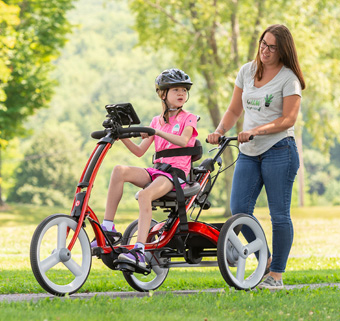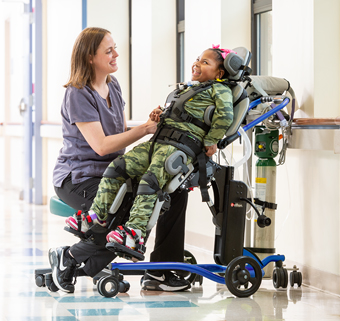Three Principles of Neural Plasticity to Apply in Your Rehabilitation Practice.
| December 2013 There has been a great deal of interest in recent years in the study of plasticity in the nervous system. Plasticity simply means the capacity of the central nervous system to adapt and change. Changes in the structure and function of the nervous system accompany improvements in motor skills that happen with learning and with rehabilitation after neurological damage. Although much of the work on neural plasticity is from the basic sciences, there are definite principles that we can already apply to our clinical work.
There has been a great deal of interest in recent years in the study of plasticity in the nervous system. Plasticity simply means the capacity of the central nervous system to adapt and change. Changes in the structure and function of the nervous system accompany improvements in motor skills that happen with learning and with rehabilitation after neurological damage. Although much of the work on neural plasticity is from the basic sciences, there are definite principles that we can already apply to our clinical work.
Intensive Motor Skills Practice
Intense practice of motor skills with enough repetition enhances both the adaptive changes in the brain and improved skills. (Kleim, Jones, 2008) This is already well supported by motor learning research. Common sense also tells us that a greater amount of practice will bring about more learning. It does appear to be important that such practice consists of motor skill learning and not simply repetitions of movement. This includes making sure that the skills practiced are meaningful to the individual. Some of the research on the effects of intense motor skills practice on plasticity has been with constraint-induced movement therapy following stroke. (Liepert et al. 2000) In this particular study, significant functional improvement in motor performance was paralleled by measurable changes in the cortex after intensive active practice with the involved upper extremity. This improvement was noted even years after stroke. In pediatric settings (and now also adult settings) the MOVE Program is one structured method for encouraging intensive motor skills practice. (Bidabe 1999)
Enriched Environments
One factor that has been studied extensively in animal models is an enriched environment. Providing the recovering brain with stimuli such as increased physical activity, more social interaction, and interesting sensory stimuli (novel objects or problem-solving opportunities) definitely enhances both functional recovery and the underlying neural processes including synaptic plasticity and increased white matter. (Lee et al. 2013, Yang et al. 2012) These are all factors to consider during rehabilitation and can be provided fairly easily to our patients with neurological impairments. An enriched environment has also been studied with human subjects recovering from stroke. (Janssen et al. 2013, Teasell et al. 2005) Think about the importance of giving opportunities for more physical activity (using equipment as needed to support the learner). Communicating directly to an individual and offering chances for more social interaction is also crucial, and can happen quite naturally in many enriched settings. If we look with a critical eye at the sensory environment of our clients we will also see ways that it could be made more interesting with colors, pictures, music, plants, or textures. Attention to all of these environmental factors will help give our clients the optimal chance for functional and neurological gains.
Aerobic Exercise
Physical activity in itself, particularly aerobic activity, enhances neural plasticity.
Aerobic exercise is a specific extension of activity-based therapies for promoting plasticity. Although the benefits of aerobic exercise in preventing or reversing cognitive and neural deterioration have yet to be fully investigated, substantial human and preclinical data support the utility of such exercise for promoting brain plasticity and improving CNS function in many conditions. (Cramer et al. 2011)
For some of the populations we work with, especially those with more severe physical disability, it is challenging to think of ways to allow them to get more physical and aerobic activity. Here is one place that adaptive equipment can be helpful to support a person in an upright position or to bear some of the weight during exercise. Some examples are body-weight supported treadmill training or the use of a gait trainer for overground training and exercise.
These are only three principles of neural plasticity that can have a bearing on our rehabilitation practice. There are others. As therapists we would do well to try to learn as much as possible about this science and the clinical implications. Understanding the changes that are possible within the nervous system can give us a more optimistic perspective in our work and spell hope for our patients.
Recommended Reading
Kleim JA, Jones TA. (2008) Principles of experience-dependent neural plasticity: implications for rehabilitation after brain damage. J Speech Lang Hear Res. Feb;51(1):S225-39.
References
Bidabe, DL. (1999) MOVE: Mobility Opportunities Via Education. Bakersfield, CA: Kern County Superintendent of Schools.
Cramer SC, et al. (2011) Harnessing neuroplasticity for clinical applications. Brain 134(6):1591-1609. PMID 21482550
Damiano DL. (2006) Activity, activity, activity: Rethinking our physical therapy approach to Cerebral Palsy.Physical Therapy 86(11):1534-1540. PMID 17094192
Janssen H, Ada L, Bernhardt J, McElduff P, Pollack M, Nilsson M, Spratt NJ. (2013) An enriched environment increases activity in stroke patients undergoing rehabilitation in a mixed rehabilitation unit: a pilot non-randomized controlled trial. Disabil Rehabil. Apr 29. PMID: 23627534
Kleim JA, Jones TA. (2008) Principles of experience-dependent neural plasticity: implications for rehabilitation after brain damage. J Speech Lang Hear Res. Feb;51(1):S225-39. PMID 18230848
Lee MY, Yu JH, Kim JY, Seo JH, Park ES, Kim CH, Kim H, Cho SR. (2013) Alteration of synaptic activity-regulating genes underlying functional improvement by long-term exposure to an enriched environment in the adult brain. Neurorehabil Neural Repair. Jul-Aug;27(6):561-74. PMID: 23558143
Liepert J, Bauder H, Wolfgang HR, Miltner WH, Taub E, Weiller C. (2000) Treatment-induced cortical reorganization after stroke in humans. Stroke. 31(6):1210-1216. PMID: 10835434
Teasell R, Bitensky J, Foley N, Bayona NA. (2005) Training and stimulation in post stroke recovery brain reorganization. Top Stroke Rehabil. 12(3):37-45. PMID: 16110426
Thomson G. (2005) Children with Severe Disabilities and the MOVE Curriculum; Foundations of a Task-Oriented Therapy Approach. Chester NY: East River Press.
Yang S, Lu W, Zhou DS, Tang Y.(2012) Enriched environment and white matter in aging brain. Anat Rec (Hoboken). Sep;295(9):1406-14. PMID: 22777883




